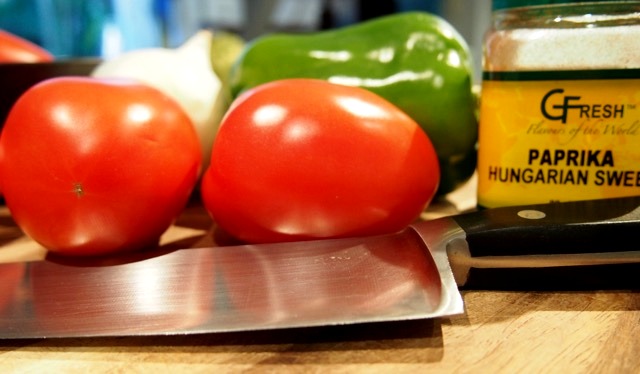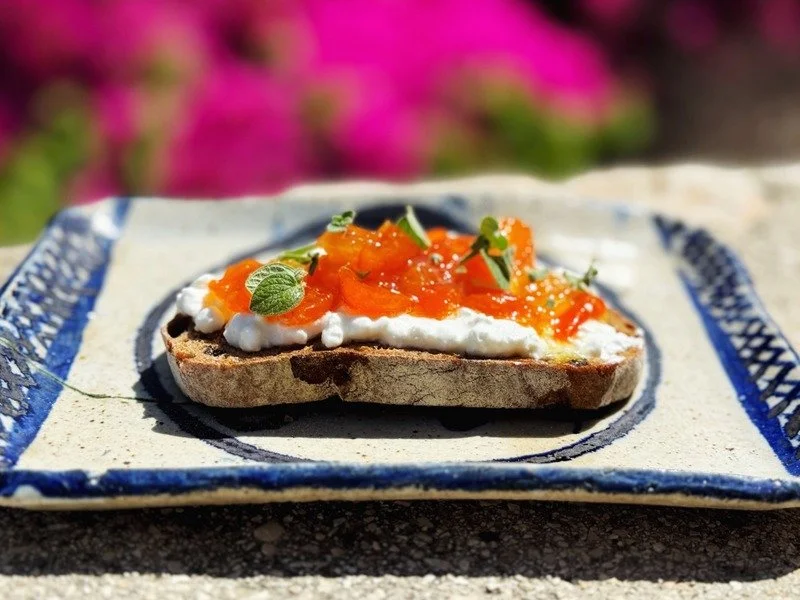Matboucha and Lecso
So this week it’s tomatoes. Hum. Gloat. Little skip of glee. Tomatoes are one of my favourite vegetables – even though they are technically fruit. In Australia I spend a lot of time searching for tomatoes that taste real, but rarely find them. No need to search high and low in Jerusalem. One of the best things about living here is how good the tomatoes are.
They smell peppery and dusty, as if they just came out of the earth, like the lot I bought today. And the cream of the crop for salads, the cherry tomatoes, are sweet and bursting with flavour.
“They’re like ice cream!” an Australian friend exclaimed, as we ate them out of the punnet like cherries or blueberries, with no adornment of any kind.
So when the opportunity came to to do a story with one of the Israeli growers I grabbed it. The farm was down south, near the border with Gaza and Egypt. It’s as hot as Hades down there and inside the greenhouse it was even hotter. Regularly timed sprays of water left moisture literally hanging in the air. Through the sweaty haze, the tomatoes gave off a fruity, peppery scent that was overpowering.
I asked what made these tomatoes so sweet. The soil they grew in didn’t look like much. It was basically sand. The greenhouse manager explained that there were many factors, including picking the tomatoes as ripe as possible off the vine. They should be red, not green. They should not be held in cold storage for 12 months and sprayed with some gas to turn them red, as still happens in Australia. If they’re tasteless, it’s because they’re not really ripe.
Sun and water also make a difference. They've found - and it's counter-intuitive - that the saltier the water, the sweeter the tomato, as long as it doesn't reach a tipping point where it spoils the fruit. I wrote all this down diligently, the humidity making smudges on the page, and then making writing impossible. That's when it was time for eating.
Hungary and North Africa
This week we're preparing two tomato dishes, one from North Africa and the other from Hungary, staples in both kitchens, with similar ingredients. Both are popular with the grandmothers from this project.
Rina Mevorach, the grandmother who lived through the German occupation of Libya during World War Two makes Matboucha, and it is also part of the Moroccan and Algerian Jewish kitchens. Rosa Bagdadli, who was born in Greece, also makes Matboucha. Rosa makes Matboucha even though it is not a Greek dish. It has become an Israeli one, part of the salads served as a first course on a Friday night.
basics
Matboucha is tomatoes, cooked till they are thick and syrupy, and served at room temperature as a salad. It’s as if you are making a pasta sauce and then keep reducing till all the liquidis gone. Some versions add red capsicums, others don't.
I first ate the tomato only version of Matboucha in 2003, in a flyblown desert town on the border of Jordan and Iraq, waiting to go in to cover the US invasion. This was the Jordanian version, and our local fixer prepared it for breakfast each morning, till I became addicted.
There is always chilli, garlic and paprika. They are non-negotiable. For another layer of flavour you can add red peppers.
I'm suggesting the simplest version here ie tomato, garlic and chilli only, which is how Food is Love grandmothers Rina and Rosa make it. While it is also delicious with capsicum, I don’t feel their lack, and it is a significant saving in time and work.
The secret to matboucha is to simmer it for a long time, until all liquids have evaporated. You can adjust the amount of chili to make it as spicy or as mild as you’d like. I like mine salty, in honour of my Jordanian fixer’s version. Grandmothers Rina and Rosa use less salt.
Matboucha
Serves 2 or 3, or more as part of a larger mezze table.
INGREDIENTS
- 2 kilograms / 4.5 pounds tomatoes, peeled
- 8 garlic cloves
- 3 chilli peppers-- or less - or none, if you don't like spicy!
- 1 tablespoon sweet paprika
- Salt and pepper
- 3 tablespoons vegetable oil - olive oil or canola
- optional: 3 -4 red capsicums, roasted
method
1. Peel your tomatoes. In the end, I do think this step is unavoidable. My usual method, is to cut a cross in the skin and dip the tomatoes in boiling water. After 30 seconds, when the skin starts to split, plunge them into a bowl of cold water and peel.
2. Roughly chop the tomatoes, the chilli peppers and the garlic cloves. The garlic pieces can be large – halves or thirds will do.
3. Set a pot over low heat, and warm the oil. Add the garlic, stirring for just a few seconds, without allowing it to colour. You are just flavouring the oil. Add the tomatoes, stir, and cover. Allow to cook, over low heat, for an hour.
4. Chop the hot peppers and add to the pot. If you want to go the extra mile, grill them until you blacken the skins. Place them in a plastic or paper bag, and rub them. They will shed their skins, like snakes. Peel, chop and add to the pot.
5. Add the paprika, salt and pepper. Stir, and cook uncovered, on a low flame, for approximately another hour until all of the liquid has evaporated. Check - it may also start to burn.
The salad should be thick. I have cooked it for less time, as it does firm up if you put it in the fridge. It will keep for up to a week there. I'm told that it freezes well, but I have never frozen it myself.
This lot of spring tomatoes were so sweet, they produced the sweetest Matboucha I've ever made. Just goes to show, the quality of the ingredients is crucial! I served it in a grain bowl, inspired by an American caterer with Israeli roots, Vered Guttman. Lentils, freekeh, matboucha, cracked olives, Japanese pickled ginger, and slices of white cheese or seared tofu. Top with a few roasted hazelnuts, and finely sliced nori or spring onions, if you like, too.
test kitchen reports
In Madrid, Candice also prepared Matboucha. She enjoyed her experience with the carrot fritters so much, that she's back for a second week! She said her Matboucha had a lovely rich colour, but was a little too sweet. She did add red peppers ie capsicums but not enough chilli.
“The sweetness may be due to my choice of Kumato as my tomato. I love their color (anywhere from black to green with red highlights) and flavour. Also thought using a hybrid developed in Spain, would give it a bit of a local touch. Next time, I'll add something with some real punch like jalepeño or perhaps a dash of berbere spice. And I won't use the Kumato," she says ruefully.
"I served the Matboucha with a sturdy Spanish rosé, some flat-bread and two North African dishes: spicy lentils and broad bean ‘ful’. Tasty."
In Sydney, where winter is settling in, Margo made her Matboucha with tinned tomatoes, just as I was asking myself whether that would work.
“I must confess, I cheated shameless this week and used tinned tomatoes. I can't quite call mine a 'salad', but the result however is tasty and firm and would make a great bonus to an antipasto plate. I shall try it as spaghetti sauce this evening.”
So it seems the answer to that question is yes. Thanks Margo!
Lecso
There as just as many versions of the Hungarian favourite, Lecso – pronounced lecho.
ingredients
- 1 kg / 2.25 lb / 6 green bell peppers (capsicum)
- 500 g / 1 lb / 4 large tomatoes
- 1 onion
- 4 tablespoons oil
- 1 heaped tablespoon ground paprika
- Salt
- Plus – see below: sausage, eggs or rice
Essentially, this is also tomato and capsicum cooked together with paprika, like in the Matboucha, but more capsicums than tomatoes, you won’t get away with leaving them out of this dish! Then it's not left plain. They usually they add protein, most often sausage, or egg; and/or also carbs, like rice or pasta. The classic version is made with bacon fat – for obvious reasons, that doesn't work in the Jewish kitchen!
For Agi Adler, one of our grandmothers who was born in Budapest, this dish is the taste of home. She emerged from World War Two a teenager and an orphan, and she prepares it the way her mother did, with rice. Baba Schwartz, also born in Hungary, still prepares lesco regularly, and served it to me, when I dropped by for a surprise lunch, adding fried eggs.
method
- Finely chop the onion and fry in hot oil, until translucent. Remove from heat and stir in the paprika.
- While the onion is frying, remove the stalks and seeds from the peppers, and cut into rings. Chop the tomatoes.
- Add the peppers and salt to the pan, and cover with a lid. Simmer gently for about 10 minutes, then add the tomatoes and cook until soft and pulpy, another 20 minutes or so.
LECSO WITH SAUSAGE
When you are ready to serve, add 200 g / 6 oz sausage to the pan. Hungarians use Debrecziner; frankfurters or chorizo are both also good. The sausage is usually sliced, but it can also be left whole. Cook for a few minutes till all the tastes meld.
LECSO WITH EGGS
Serve 1-2 eggs per person. Beat with a little salt. Pour over the cooked vegetables, and heat, stirring, until the egg begins to set. Depending how much you stir, It ends up like something between an omelette and a scrambled eggs with vegetables.
LECSO WITH RICE
Fry 1/2 cup of white rice in a little oil, then add to the pan. It adds flavour, but if you want to cut down on oil, you can skip this step, and just put the rice straight into the pan. Cook over a low heat. The rice will swell in the vegetable juice. Watch it, in case it needs more water. Agi Adler usually makes it with rice, but she will also add sausage if she wants this dish to be a full meal.
test kitchen reports
In Sydney, Judy, graphic designer and cook, served it plain, more like the Matboucha, the way her mother Klari, a Czech Holocaust survivor, always did. For Judy, born in Sydney, this is also the taste of home.
In Melbourne, in her gluten free, fructose free kitchen, Amanda was sold on the dish from the moment she began cooking.
"Oh wow this smelt sooooooooo good!!!! Looks amazing, cannot wait to serve for Friday night dinner :) Made me feel like I was back in a little cafe in Budapest somewhere... Probably over on Buda. Overlooking the river. Hahaha!!"
Looks like I might be away next week, so we might not have a new recipe. I will write though, since I am travelling for work. Wanted to end on a lovely comment about this website from the South African food blogger, Tandy Sinclair. On her blog Lavender and Lime, she said Food is Love is one of the most moving sites she's visited. Hope it is for you too!

























